The market inched closer to record high levels but erased all its gains in the last couple of sessions amid volatility to end flat on February 12. Selling pressure was in FMCG, metals and pharma stocks. However, banking & financials provided strong support.
The BSE Sensex was up 12.78 points at 51,544.30, while the Nifty50 declined 10 points to 15,163.30 and formed a Doji pattern on the daily charts. The index gained 1.6 percent during the week and formed a small bullish candle on the weekly scale.
"During the week we saw maximum activity in medium-sized and small-sized companies. Going ahead, these mid and small-size companies could hurt the market if the Nifty50 index fails to break the 15,260 levels," Shrikant Chouhan, Executive Vice President, Equity Technical Research at Kotak Securities told Moneycontrol.
"Based on the chart of largecap companies, the weakness is increasing in the short-term, and it would probably lead to a quick correction to the level of 14,850 or 14,750," he said, adding if the Nifty50 index crosses 15,270 for the 15,500 levels, it would be advisable to buy.
"Fall below 15,100 will lead to further weakness," he said.
The broader markets outperformed frontliners on the weekly basis. The Nifty Midcap 100 and Nifty Smallcap 100 indices gained 2.18 percent and 3.85 percent, respectively, during the week.
We have collated 15 data points to help you spot profitable trades:
Note: The open interest (OI) and volume data of stocks given in this story are the aggregates of three- month data and not of the current month only.
Key support and resistance levels on the Nifty
According to pivot charts, the key support levels for the Nifty are placed at 15,081.7, followed by 15,000.1. If the index moves up, the key resistance levels to watch out for are 15,244.2 and 15,325.1.
Nifty Bank
The Nifty Bank smartly outpaced Nifty50, rising 356.80 points or 1 percent to 36,108.90 on February 12. The important pivot level, which will act as crucial support for the index, is placed at 35,765.13, followed by 35,421.36. On the upside, key resistance levels are placed at 36,387.73 and 36,666.57.
Call option data
Maximum Call open interest of 20.59 lakh contracts was seen at 15,500 strike, which will act as a crucial resistance level in the February series.
This is followed by 16,000 strike, which holds 20.54 lakh contracts, and 15,200 strike, which has accumulated 10.90 lakh contracts.
Call writing was seen at 15,800 strike, which added 2.17 lakh contracts, followed by 15,600 strike which added 1.99 lakh contracts and 15,100 strike which added 1.89 lakh contracts.
Call unwinding was seen at 15,000 strike, which shed 87,000 contracts, followed by 14,800 strike which shed 38,025 contracts and 14,500 strike which shed 33,150 contracts.

Put option data
Maximum Put open interest of 18.25 lakh contracts was seen at 14,500 strike, which will act as crucial support level in the February series.
This is followed by 15,000 strike, which holds 16.36 lakh contracts, and 14,200 strike, which has accumulated 13.08 lakh contracts.
Put writing was seen at 14,400 strike, which added 1.09 lakh contracts, followed by 15,200 strike, which added 99,000 contracts and 14,300 strike which added 89,700 contracts.
Put unwinding was seen at 14,500 strike, which shed 95,925 contracts, followed by 14,200 strike which shed 7,725 contracts.
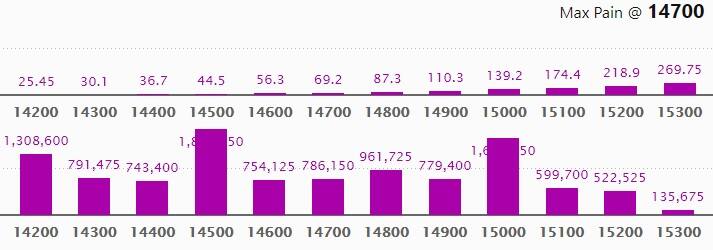
Stocks with a high delivery percentage
A high delivery percentage suggests that investors are showing interest in these stocks.
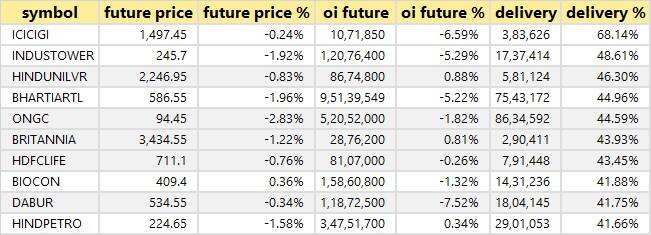
15 stocks saw long build-up
Based on the open interest future percentage, here are the top 10 stocks in which a long build-up was seen.
48 stocks saw long unwinding
Based on the open interest future percentage, here are the top 10 stocks in which long unwinding was seen.
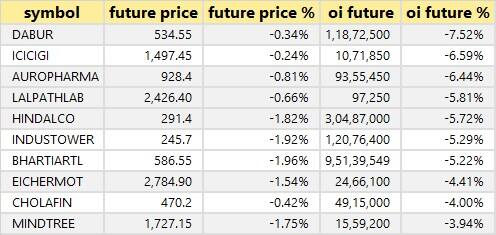
49 stocks saw short build-up
An increase in open interest along with a decrease in price mostly indicates a build-up of short positions. Based on the open interest future percentage, here are the top 10 stocks in which a short build-up was seen.
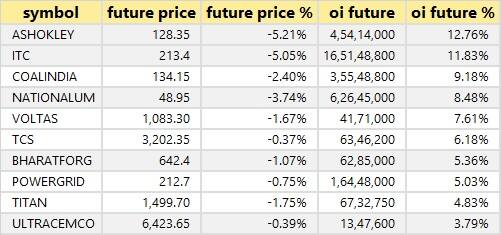
30 stocks witnessed short-covering
A decrease in open interest along with an increase in price mostly indicates a short-covering. Based on the open interest future percentage, here are the top 10 stocks in which short-covering was seen.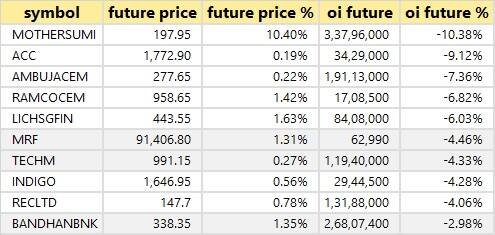
Bulk deals

(For more bulk deals, click here)
Jet Airways, Alora Trading Company, Advance Syntex, CDG Petchem, Emmsons International, Eureka Industries, Hawa Engineers, Hindustan Everest Tools, JIK Industries, Kerala Ayurveda, PG Foils, Archana Software, Sunraj Diamond Exports, Vishvprabha Ventures and Vantage Knowledge Academy are among 23 companies to announce their quarterly earnings on February 15.
Stocks in the news
Mazagon Dock Shipbuilders: The company reported a consolidated profit of Rs 141.4 crore in Q3 FY21 against Rs 208.7 crore in Q3 FY20. Revenue fell to Rs 1,461.1 crore from Rs 1,810.9 crore.
Indiabulls Housing Finance: The company reported a profit of Rs 329 crore in Q3 FY21 against Rs 273 crore in Q3 FY20. Net interest income rose to Rs 809 crore from Rs 731 crore.
Siemens: The company reported a consolidated profit of Rs 295.5 crore in December quarter 2020 against Rs 265.8 crore in December quarter 2019. Revenue rose to Rs 2,925.5 crore from Rs 2,537 crore.
Deepak Nitrite: The company reported a consolidated profit of Rs 216.56 crore in Q3 FY21 against Rs 156.71 crore in Q3 FY20. Revenue rose to Rs 1,234.7 crore from Rs 1,119.86 crore.
Sobha: The company reported a consolidated profit of Rs 21.6 crore in Q3 FY21 against Rs 73.2 crore in Q3 FY20. Revenue fell to Rs 684.4 crore from Rs 883.2 crore.
Dilip Buildcon: The company reported a consolidated profit of Rs 182.23 crore in Q3 FY21 against Rs 88.07 crore in Q3 FY20. Revenue increased to Rs 2,746.2 crore from Rs 2,564.4 crore.
Fund flow

FII and DII data
Foreign institutional investors (FIIs) net sold shares worth Rs 37.33 crore, while domestic institutional investors (DIIs) net sold shares worth Rs 597.62 crore in the Indian equity market on February 12, as per provisional data available on the NSE.
Stocks under F&O ban on NSE
Two stocks - BHEL and SAIL - are under the F&O ban for February 15. Securities in the ban period under the F&O segment include companies in which the security has crossed 95 percent of the market-wide position limit.